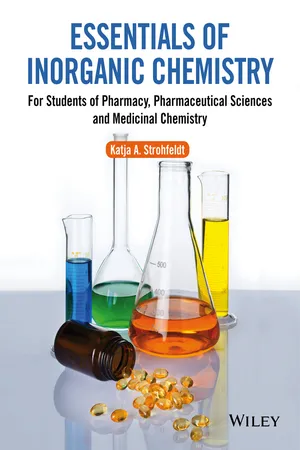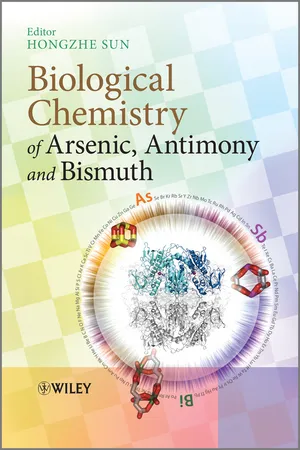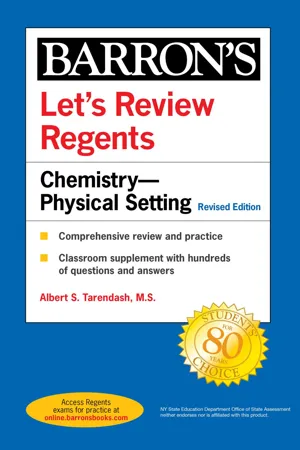Chemistry
Group 5A
Group 5A refers to the nitrogen group of elements in the periodic table, which includes nitrogen (N), phosphorus (P), arsenic (As), antimony (Sb), and bismuth (Bi). These elements share similar chemical properties, such as forming compounds with a -3 oxidation state and often acting as nonmetals. They are important in various industrial and biological processes, including the nitrogen cycle and the production of fertilizers.
Written by Perlego with AI-assistance
3 Key excerpts on "Group 5A"
- eBook - ePub
Essentials of Inorganic Chemistry
For Students of Pharmacy, Pharmaceutical Sciences and Medicinal Chemistry
- Katja A. Strohfeldt(Author)
- 2015(Publication Date)
- Wiley(Publisher)
Chapter 6 Group 15 ElementsMembers of group 15 of the periodic table (15th vertical column) are summarised as group 15 elements (or the nitrogen group) consisting of nitrogen (N), phosphorus (P), arsenic (As), antimony (Sb) and bismuth (Bi) (Figure 6.1 ).Periodic table of elements. Group 15 elements are highlightedFigure 6.1The appearance of group 15 elements varies widely, reflecting the changing nature of the elements when descending within the group from nonmetal to metal. This trend can be seen both in their structures as well as in their chemical and physical properties. Nitrogen is a colourless and odourless gas. Phosphorous exists as white, red and black solids, whereas arsenic is found as yellow and grey solids. Antimony presents itself in a metallic grey form, and bismuth is a white crystalline metal.Nitrogen atoms are included in a variety of organic drugs, and their application will not further be discussed in this book. Phosphorus is also an essential element for human life, and some of its biochemical uses as well as clinical applications will be discussed in Section 6.2. The clinical use of arsenic is known as thestart of chemotherapy. Arsenic, despite its known toxicity, is still clinically used to combat a variety of diseases including cancer (see Section 6.3).6.1 Chemistry of group 15 elements
6.1.1 Occurrence and extraction
Nitrogen makes up 78% (by volume) of air, whereas phosphorus can be found in several minerals and ores. Phosphorus is an essential constituent of plants and animals, being present in deoxyribonucleic acid (DNA), bones, teeth and other components of high biological importance. Phosphorus does not occur in its elemental state in nature, as it readily oxidises and therefore is deposited as phosphate rock. The remaining elements of group 15 are mostly obtained from minerals, but can also be found in their elemental form in the earth's crust. Arsenic is mostly presented in nature as mispickel (FeAsS), realgar (As4 S4 ) and orpiment (As2 S3 ). Bismuth occurs as bismuthinite (Bi2 S3 - Hongzhe Sun, Hongzhe Sun(Authors)
- 2010(Publication Date)
- Wiley(Publisher)
Chapter 1 The Chemistry of Arsenic, Antimony and Bismuth Neil Burford, Yuen-ying Carpenter, Eamonn Conrad and Cheryl D.L. Saunders Department of Chemistry, Dalhousie University, Halifax, Nova Scotia, B3H 4J3, CanadaArsenic, antimony and bismuth are the heavier pnictogen (Group 15) elements and consistent with their lighter congeners, nitrogen and phosphorus, they adopt the ground state electron configuration ns 2 np 3 . Arsenic and antimony are considered to be metalloids and bismuth is metallic, while nitrogen and phosphorus are non-metals. Arsenic and antimony are renowned for their toxicity or negative bioactivity [1, 2] but bismuth is well known to provide therapeutic responses or demonstrate a positive bioactivity [3]. As a background to the biological and medicinal chemistry of these elements, the fundamental chemical properties of arsenic, antimony and bismuth are presented in this introductory chapter.1.1 Properties of the ElementsSelected fundamental parameters that define the heavier pnictogen elements are summarized in Table 1.1 [4]. While arsenic and bismuth are monoisotopic, antimony exists as two substantially abundant naturally occurring isotopes. All isotopes of the heavy pnictogens are NMR active nuclei, indicating that the nuclear spin will interact with an applied magnetic field. However, as the nuclear spins of these isotopes are all quadrupolar, NMR spectra generally consist of broad peaks and provide limited information. The atoms As, Sb and Bi all have the same effective nuclear charge (Zeff = 6.30, Slater), which estimates the charge experienced by a valence electron taking into account shielding by the other electrons. As a consequence, the ionization energies and electron affinities for As, Sb and Bi are very similar. The ionization energy is the energy required to remove a valence electron from an atom or an ion in the gas phase. The ionization energies are predictably greater for ions with higher positive charge and are typically lower for atoms or ions with higher principal quantum number (n). The electron affinity is the energy released when an atom gains an electron to form an anion in the gas phase. The electronegativity (χP- Albert S. Tarendash(Author)
- 2021(Publication Date)
- Barrons Educational Services(Publisher)
Chapter 10 ). The relative inactivity of nitrogen gas in the atmosphere is due to the fact that considerable energy is needed to break the triple bond. Nitrogen is nonmetallic. Phosphorus (P), also a nonmetal, exists in two allotropic forms: red and white.Group 16
Each element in Group 16 has six valence electrons. Oxygen (O), a nonmetal, exists in nature in two allotropic forms, O2 and O3 (ozone). It readily forms a 2− ion. Sulfur (S) is also a nonmetal; it exists in several allotropic forms and can form a 2– ion although it is less reactive than oxygen. Selenium (Se) and tellurium (Te) are classified as metalloids, and polonium (Po) is considered a metal.Group 17
The elements in Group 17 are known as the halogens. Each element has seven valence electrons. All of these elements are nonmetals that form 1− ions. They are the most reactive of the nonmetallic elements, with fluorine (F) being the most reactive element in this group. Fluorine and chlorine (Cl) are gases at room temperature; bromine (Br) is a liquid, and iodine (I) is a solid. Because of their reactivity, the halogens do not occur as free elements in nature.Group 18
The elements in Group 18 are known as the noble (or inert) gases. Each element other than helium has eight valence electrons. Although helium (He) has only two valence electrons, it is associated with this group because its properties match those of the other elements. The elements of Group 18 are extremely stable and occur as monatomic gases in nature. Although they do not combine readily with other elements, compounds of krypton (Kr) and xenon (Xe) have been prepared.The Transition Elements
The transition elements begin in Period 4 and include Groups 3–11. (Group 12 elements are not considered transition elements.) The transition elements exhibit multiple oxidation states because the two
Index pages curate the most relevant extracts from our library of academic textbooks. They’ve been created using an in-house natural language model (NLM), each adding context and meaning to key research topics.
Explore more topic indexes
Explore more topic indexes
1 of 6
Explore more topic indexes
1 of 4


